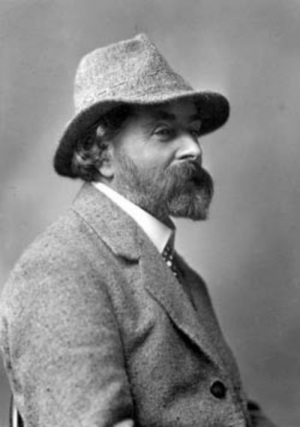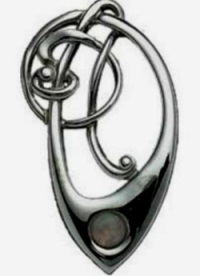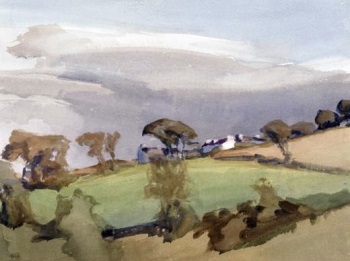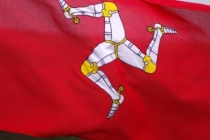Archibald Knox - Anonymous Celtic Design Genius

Archibald Knox (09 April 1864 – 22 February 1933) was a Manx artist and designer now associated with the Art Nouveau movement although by all accounts he would not like to have been categorised as such. His designs were more informed by his Celtic roots rather than the spread of art nouveau as expressed on the continent. His inspiration being the landscape and Celtic carvings on the stones and monuments that he had seen on his native Isle of Man (Mannin). However, the art nouveau movement of the late 19th and early 20th centuries was heavily influenced by natural structures and forms. This international movement has different names in various countries; for example in Germany Art Nouveau is more commonly known as Jugendstil, taking its name from the magazine Jugend. However, it was in the Belgian journal L’Art Moderne during the 1880’s that the term Art Nouveau appeared when describing the work of Les Vingt.
Art Nouveau and was seen as both a style and philosophy that drew inspiration from the natural world rather than looking back into history and recreating historical styles. It was heavily influenced by the Arts and Crafts movement which sought to promote handicraft and skilled workmanship at a time when industrialisation was seen to be debasing the work of skilled artisans through the process of mass production. The Art Nouveau movement encompassed all aspects of art, design and architecture and was developed by a generation of skilled and energetic designers and artists who sought to advance an art form appropriate to the modern age. Those associated with the movement included Charles Rennie Mackintosh Scottish artist, designer and architect. Aubrey Beardsley, illustrator and author. American artist and designer Louis Comfort Tiffany who is particularly known for his work in stained glass. René Jules Lalique, French glass designer. Émile Gallé French artist in wood, glass and ceramics. Flemish designer and designer Victor Horta. Czech painter and decorative artist Alfons Mucha.

Archibald Knox’s interest in Celtic Art is clearly revealed in his designs. Celtic art is that associated with the people who spoke the Celtic languages of Europe from pre-history until the modern period. Continuity in decoration and style can be seen from the Neolithic age right through into early Celtic art and the medieval period. A continuity that reflects the revision of old theories of invasion and migration to the position held by many today where the Celts of present day northwest Europe are seen as the direct descendants of the ancient people of pre-history who inhabited these lands. The designs and patternation of later work can be seen to have a striking similarity to that on the megalithic carvings found on the ancient monuments of Ireland, Brittany and the other nations defined as Celtic today. Designs that carried on into the metalwork, torcs, items of jewellery found in the Bronze age, Iron Age and through to the present. A feature of which is the distinctive knot work, spiral designs, decorative themes and curvilinear lines that give a sense of balance in their layout.

Archibald Knox became a prolific designer for Liberty & Co the famous London department store. During the early years of the twentieth century he was the master designer for Liberty’s new range of Celtic metalwork and jewellery range. By nature he was a very private man who did not seek self-promotion. This suited the founder of Liberty & Co, Arthur Lazenby Liberty, who had strict policy of not attributing the objects on sale to their designers. Archibald Knox remained a reserved man throughout his life. His privacy only really punctured by what can be gleaned from his remarkable artistic creations. His unique style is obvious in the years 1897 to 1908, when he was most engaged in his work with the store. Indeed it was Archibald Knox who designed the gravestone of Arthur Lazenby Liberty who died in 1917.

After a period teaching in London and a brief time spent in the United States, Archibald Knox returned to his native Isle of Man in 1913. He taught art in local schools, painted landscapes, which like so much of his early designs were inspired by the Manx countryside. He beautifully illustrated two manuscripts The Deer’s Cry and the Book of Remembrance. Knox’s version of the Deer’s Cry is based upon the early Irish prayer The Deer’s Cry or Lorica (Breastplate) of St Patrick contained in the ancient Irish manuscript the Book of Armagh. Parts of the Book of Armagh were at one time said to be by Patrick’s own hand. However, it has been dated to 807AD and the earliest part of the manuscript was the work of Ferdomnach of Armagh some hundreds of years after the death of the fifth century St Patrick. Copied into the book were extracts of the writings of the seventh century monk Muirchú who wrote an account of the life of St Patrick. The Book of Armagh is a remarkable manuscript written mostly in Latin and also contains some of the oldest examples of Old Irish. This is the ancient Gaelic language that is the ancestor of modern Irish, Scottish and Manx Gaelic.
It is in the Book of Armagh that is copied the Deer’s Cry, which is a poem or prayer of protection. It is from this early Irish prayer that Archibald Knox based his beautiful water-colour manuscript which is widely acclaimed as a masterpiece. This work also reflects his strong Christian faith and Oik Postagh Ellan Vannin (Isle of Man Post Office) has recently released a new set of stamps featuring designs from Archibald Knox’s Deer’s Cry. This stamp release is a very welcome tribute to Archibald Knox who was a skilled water-colourist and exhibited in the 1920’s abroad in Britain and also Canada. Although a private and unassuming man he would have been delighted to be remembered for his superb designs and skilled artistry.
He died in 1933 and the simple inscription on his gravestone says it all ‘Archibald Knox, Humble Servant of God in the Ministry of the Beautiful’. He lies in new Braddan graveyard in his beloved Manx homeland. Not far from his final resting place is Old Braddan Church which now houses several Celtic and Norse Crosses. Celtic Crosses (Manx Gaelic: Crosh Cheltiagh) like those found throughout the Celtic nations; intricately and richly carved by the hands of skilled craftsmen that so inspired some of Archibald Knox’s own work. Further information on the designs of Archibald Knox can be seen on the Archibald Knox Society Website.
- Manx
- English
- Log in to post comments






